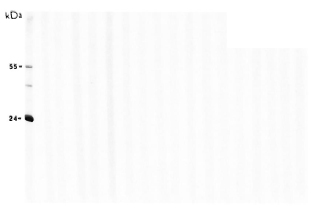- Volume 57 , Number 4
- Page: 866–7
Failure to detect antibodies to HIV-1 in sera f rom patients with mycobacterial infections
To the Editor:
The infection of humans with the human immunodeficiency virus type 1 (HIV-1) initiates a slow progressive degeneration of the immune and central nervous system (1,3). The resulting complex disorder clinically recognized as the acquired immunodeficiency syndrome (AIDS) is often complicated by mycobacterial infections (2). Recently, SrivRaj, et al. (6) published in the Journal an article indicating that when tested by immunoblotting, sera from 76.6% of leprosy patients (33 out of 43), 33.3% of tuberculosis patients (7 out of 21), and 80% of leprosy contacts (4 out of 5) contain IgG class antibodies against HIV-1. The IgG antibodies specific for HIV-1 p24, the major antigen of this virus, were present in 17 of these 69 persons. None of 63 healthy controls had anti-HIV p24, and only one control tested positive for anti-HIV p17. On the basis of these results, the authors claim that HIV-1 and mycobacteria share common antigenic determinants. This could have important implications for the development of HIV vaccines, which (if the antibodies were neutralizing) could consist of relevant neutralizing HIV antibody-inducing antigenic determinants of mycobacteria.
In order to study this possibility, we decided to examine the HIV-binding and HIV-neutralizing capacity of leprosy sera. The sera were obtained from 16 patients with lepromatous leprosy, 6 patients with tuberculoid leprosy, and 10 control healthy volunteers in two different areas, Agra in India and Surabaya in Indonesia. For the detection of anti-HIV-1 antibodies, we used a sensitive and specific immunoblotting procedure described in detail elsewhere (7). In brief, after the separation on SDS-polyac-rylamide gels, protein preparation from H9 cells infected with the HTLV-III,, isolate of HIV-1 (5) and from control uninfected H9 cells were blotted onto nitrocellulose, and the nitrocellulose strips with blotted proteins were exposed to the sera, including positive and negative controls. The reaction of the sera with HIV-proteins was visualized using 125I-labeled mouse monoclonal anti-human IgG and autoradiography (The Figure). None of the 22 sera from patients with leprosy contained IgG antibodies specific for HIV-1 proteins, although weak binding for non-HIV, probably cell-derived, antigens was seen on X-ray films after long exposures. Also, no leprosy serum contained antibodies capable of neutralizing the HTLV-IIIB, Ma or RF isolates of HIV-1 in the cytopathic effect inhibition assay (4). Similarly, all control sera from Agra and Surabaya regions were negative for anti-HIV antibodies.

The Figure. HIV-1 -specific immunoblots of a representative experiment demonstrating the detection of antibodies to HIV-1 antigens. A serum sample from a seropositive hemophiliac (track 1) contains HIV-1-specific antibodies (positive control); leprosy sera (tracts 2-18) clearly do not show any reactivity with HIV-1 antigens.
Since mycobacterial infections are not unusual in HIV-infected persons (2), a possible explanation for the discrepant results could be that ShivRaj and colleagues, in fact, observed dual (HIV-1 plus mycobacterial) infections in their cohort of patients. It is also conceivable that these authors observed reactions with crossreacting non-HIV antigens, possibly associated with the virus-producing cell line. This latter explanation is supported by the fact that some of the leprosy sera we tested contained antibodies reacting with antigens present in the lysates of uninfected H9 cells. In any case, we conclude on the basis of our data that sharing common determinants antigenic for humans is not a characteristic feature of HIV-1 and Mycobacterium leprae.
- Miroslav Malkovsky, M.D., Ph.D., M.R.C.Path.
Senior Scientist
Xenova Ltd.
545 Ipswich Road
Slough
Berkshire SL1 4EQ, England
- Paula Dilger, B.Sc.
Research Technician
NIBSC
- Robin Thorpe, Ph.D.
Head, Division of Immunobiology
NIBSC
Blanche Lane, South Minims
Potters Bar
Hertfordshire EN6 3QC, England
Acknowledgment. We thank Dr. Juraj Ivanyi (MRC Tuberculosis Unit, Hammersmith Hospital) for proposing this investigation and for the supply of serum samples from previous serological studies [Lepr. Rev. 59 (1988) 195-199; Lancet 1 (1987) 1098].
REFERENCES
1. Dalgleish, A. and Malkovsky, M. Advances in human retroviruses. Adv. Cancer Res. 51(1988)307-360.
2. Deo, M. G. Immunological approach for control of Mycobacterium avium-intracellulare infections in AIDS-an hypothesis. Int. J. Lepr. 56(1988)455-463.
3. Fauci, A. S. The human immunodeficiency virus: infectivity and mechanisms of pathogenesis. Science 239(1988)617-622.
4. Malkovsky, M., Newell. A. and Dalgleish, A. G. Inactivation of HIV by nonoxynol-9. Lancet 1 (1988) 645.
5. Popovic, M., Sarngadharan, M. G., Read, E. and Gallo, R. C. Detection, isolation and continuous production of cytopathic retroviruses (HTLV-III) from patients with AIDS and pre-AIDS. Science 224(1984)497-500.
6. SrivRaj, L., Patil, S. A., Girdhar, A., Sengupta, V., Desikan, K. V. and Srinivasan, H. Antibodies to HIV-1 in sera from patients with mycobacterial infection. Int. J. Lepr. 56(1988)546-551.
7. Thorpe, R., Brasher, M. D., Bird, C. R., Garrett, A. J., Jacobs, J. P., Minor, P. D. and Schild, G. C. An improved immunoblotting procedure for the detection of antibodies against HIV. J. Virol. Methods 16(1987)87-96.